Long-Term Analysis of Hydropower’s Pivotal Role in Sustainable Future of Greece
Abstract
:1. Introduction
Hydropower in the Global Electricity Generation Mix
2. Hydropower in the Greek Electricity Generation System
3. The Current Status of Hydropower Applications in the Greek Territory
4. Thirty-Year-Long Energy Analysis of the Greek Large Hydropower Plants
4.1. Energy Yield Time Variation
4.2. Capacity Factor Time Evolution
5. Thirty Years’ Long Contribution of Large Greek Hydropower Plants: Prospects and Challenges
5.1. Detailed Utilization Analysis of LHPs
- (a)
- The Aliakmon River basin contains the LHP plants of Agras (50 MWe), Assomata (108 MWe), Edesseos (19 MWe), Ilarion (153 MWe), Polifito (375 MWe) and Sfikia (315 MWe) (Figure 15). Note that Agras and Edesseos LHP stations have been erected on the Edesseos River, which is a tributary that terminates at the Aliakmon River after the LHP of Sfikia. The quite low long-term utilization degree of the Agras (the oldest Greek LHP erected in 1954) and Edesseos LHP plants (in the order of 5% and 10%, respectively) is worthwhile to notice, since these LHP plants, despite the fact that they were erected for serving an electricity generation scope, have been mainly operated for irrigation activities of the local communities.
- (b)
- The Arachthos River basin, being in the western part of Greece, contains the LHP plants of Piges Aoou (210 MWe), Pournari I (300 MWe), and Pournari II (33.6 MWe) (Figure 16). Pournari II is the smallest and the youngest one, having started its operation in 1998, and it is the last on the Arachthos River and presents the highest (13%) utilization factor in comparison with the other two LHPs. The three annual average CF curves follow the same pattern, fluctuating almost entirely below the long-term average value (16.14%). The long-term average CF values for the three LHP plants are approximately 9%, 11% and 13%, correspondingly.
- (c)
- The Achelous River basin, also in the western part of Greece, includes the biggest LHP plant, of Kremasta (437.2 MWe), and the LHPs of Kastraki (320 MWe) and Stratos I (150 MWe) (Figure 17). The LHP plants of the specific river basin are characterized by remarkably increased annual average CF values compared to the long-term average (16.14%), underlining the quite significant exploitation of the corresponding local hydropower potential. Suffice it to say that their long-term annual average CF values are in the order of 21–23%, and they present almost the same time variation for the entire thirty-year period.
- (d)
- The Nestos River basin, being in the northern part of Greece, encompasses the LHP plants of Thissavros (384 MWe) and Platanovrisi (116 MWe) (Figure 18a,b). Similarly to the previous case, the LHP plants of this river basin also present quite comparable behavior, especially during the last decade, with annual average CF values around the long-term average (16.14%). More precisely, the annual average CF values of the Platanovrisi LHP plant are constantly greater (with the exception of the years 2001, 2002, 2007, 2008 and 2024) compared to those of the Thissavros LHP plant (which can also operate as a PHS station). The same is also applicable for the long-term average CF value (18.2% for the Platanovrisi LHP plant and 14.5% for the Thissavros LHP plant).
- (e)
- Finally, Figure 19 and Figure 20 visualize the annual average CF time series for the Ladonas (70 MWe) and the Tavropos (or Plastiras) (129.9 MWe) LHP plants, respectively, which were erected in the basins of the Ladonas River (Peloponnesus) and Tavropos River (Thessaly). The Ladonas LHP plant, despite its small installed capacity, demonstrates exceptionally high annual average CF values, with its long-term average value (exceeding 33.5%) being more than twofold the commensurate value for all LHP plants (16.14%). On the other hand, the Tavropos LHP plant presents annual average CF values that fluctuate around the long-term average value.
5.2. Detailed Energy Yield Analysis of LHPs
- The first category contains the LHP plants of Agras (50 MWe), Assomata (108 MWe), Edesseos (19 MWe), Ilarion (153 MWe), Plastiras (129.9 MWe), Platanovrisi (116 MWe), Piges Aoou (210 MWe) and Pournari II (33.6 MWe). The specific category’s LHP plants have annual electricity generation values (Figure 21) that, in general terms, fluctuate below the corresponding long-term average, underlining that they have operated on the basis of mainly participating in local electricity grid management during the time period of analysis. Among them, the Agras, the Edesseos and the Pournari II, being the three smallest LHP plants, present the smaller variation, with their long-term annual electricity generation values being less than 50 GWhe. The remaining LHP plants of this category, with nominal power higher than 100 ΜWe, present greater variation with regard to the aforementioned LHP plants, with their long-term annual electricity generation value being in the range [150–250] GWhe. Moreover, the LHPs of this specific group present a mixed annual energy yield tendency (either slightly increasing or decreasing for the 30-year period examined).
- The second category comprises the LHP plants of Ladonas (70 MWe), Pournari I (300 MWe), Sfikia (315 MWe) and Stratos I (150 MWe). The main trait of this category is that the corresponding LHP plants’ long-term annual electricity generation values (Figure 22) fluctuate around the average (280 GWhe), contributing to a greater (than the first category’s LHP plants) extent to the national load demand coverage. Among them, the Ladonas LHP plant’s (which has the smallest installed capacity of this second group of LHP plants) energy generation-based performance is noticeable, considering that it presents a long-term annual average electricity generation value almost equal to 220 GWhe and a corresponding long-term annual average CF value in the order of 35% (Figure 19). On the other hand, the Sfikia LHP plant, which has the highest installed capacity among the second category’s LHP plants, has a long-term annual average energy generation value in the order of 350 GWhe and a corresponding long-term annual average CF value in the order of 13% (Figure 15d), greatly bringing into question the viability of its financial investment up to now [42], excluding its energy storage contribution. Note also that all four LHPs present a negative long-term annual energy yield tendency.
- The third category encompasses the biggest LHP plants of Greece, i.e., the LHPs of Thissavros (384 MWe), Kastraki (320 MWe), Kremasta (437.2 MWe) and Polifito (375 MWe). The LHP plants of this category demonstrate (Figure 23) long-term annual electricity generation values significantly above the pertinent average one, strongly pinpointing their remarkable contribution to the national electricity grid balance. The greatest contribution has been realized by the Kremasta LHP plant, which presented the highest annual electricity generation values by far, while its long-term average value approached 900 GWhe. It is indicative that for the years 2006 and 2010, the specific LHP plant’s annual electricity generation was in the order of 1400–1450 GWhe, covering almost 3% of the corresponding national electricity demand and presenting an annual CF equal to 37% (Figure 17). As shown in the results in Figure 23, excluding Polifito, all the other LHP stations also present a negative long-term annual energy yield trend.
5.3. Critical Analysis of the LHPs’ Development
6. The Large Hydropower Plants’ Capability of Providing Power Balancing/Ancillary Services to the Electricity Grid
6.1. Literature Review
6.2. The Prospects of PHS Stations in the Greek Electricity System
7. Conclusions
Funding
Data Availability Statement
Acknowledgments
Conflicts of Interest
Abbreviations
| CF | capacity factor |
| EU | European Union |
| GHG | greenhouse gas |
| HPS | Hydroelectric Power Station |
| LHP | large hydropower |
| NECP | National Energy and Climate Plan |
| PHS | pumped hydro storage |
| PPC | Public Power Corporation |
| RES | renewable energy source |
| SHP | Small Hydropower |
References
- Wagner, B.; Hauer, C.; Habersack, H. Current hydropower developments in Europe. Curr. Opin. Environ. Sustain. 2019, 37, 41–49. [Google Scholar] [CrossRef]
- Jianzhong, X.; Assenova, A.; Erokhin, V. Renewable Energy and Sustainable Development in a Resource-Abundant Country: Challenges of Wind Power Generation in Kazakhstan. Sustainability 2018, 10, 3315. [Google Scholar] [CrossRef]
- Bilgen, S.; Kaygusuz, K.; Sari, A. Renewable Energy for a Clean and Sustainable Future. Energy Sources 2004, 26, 1119–1129. [Google Scholar] [CrossRef]
- World Economic Forum. Global Risks Report. 2024. Available online: www.weforum.org (accessed on 7 February 2025).
- Tzanes, G.; Zafirakis, D.; Makropoulos, C.; Kaldellis, J.K.; Stamou, A.I. Energy vulnerability and the exercise of a data-driven analysis protocol: A comparative assessment on power generation aspects for the non-interconnected islands of Greece. Energy Policy 2023, 177, 113515. [Google Scholar] [CrossRef]
- Kapsali, M.; Kaldellis, J.K. Combining hydro and variable wind power generation by means of pumped-storage under economically viable terms. Appl. Energy 2010, 87, 3475–3485. [Google Scholar] [CrossRef]
- Lovins, A.B. Reliably integrating variable renewables: Moving grid flexibility resources from models to results. Electr. J. 2017, 30, 58–63. [Google Scholar] [CrossRef]
- International Renewable Energy Agency. The Changing Role of Hydropower: Challenges and Opportunities; International Renewable Energy Agency: Abu Dhabi, United Arab Emirates, 2023. [Google Scholar]
- Matuszewska-Janica, A.; Żebrowska-Suchodolska, D.; Ala-Karvia, U.; Hozer-Koćmiel, M. Changes in Electricity Production from Renewable Energy Sources in the European Union Countries in 2005–2019. Energies 2021, 14, 6276. [Google Scholar] [CrossRef]
- Waheed, R.; Sarwar, S.; Wei, C. The survey of economic growth, energy consumption and carbon emission. Energy Rep. 2019, 5, 1103–1115. [Google Scholar] [CrossRef]
- Kaldellis, J.K.; Boulogiorgou, D. Wind Energy Contribution in the Planet Energy Balance and Future Prospects. In Reference Module in Earth Systems and Environmental Sciences; Elsevier: Oxford, UK, 2021. [Google Scholar]
- Van Asselt, H. Governing fossil fuel production in the age of climate disruption: Towards an international law of ‘leaving it in the ground’. Earth Syst. Gov. 2021, 9, 100118. [Google Scholar] [CrossRef]
- Topolewski, L. Relationship between Energy Consumption and Economic Growth in European Countries: Evidence from Dynamic Panel Data Analysis. Energies 2021, 14, 356. [Google Scholar] [CrossRef]
- U.S. Energy Information Administration. Independent Statistics and Analysis. 2024. Available online: https://www.eia.gov/ (accessed on 7 February 2025).
- Berga, L. The Role of Hydropower in Climate Change Mitigation and Adaptation: A Review. Engineering 2016, 2, 313–318. [Google Scholar] [CrossRef]
- Chala, G.T.; Ma’Arof, M.I.N.; Sharma, R. Trends in an increased dependence towards hydropower energy utilization—A short review. Cogent. Eng. 2019, 6, 1–14. [Google Scholar] [CrossRef]
- International Hydropower Association (IHA). World Hydropower Outlook. 2024. Available online: www.hydropower.org (accessed on 7 February 2025).
- Manolopoulos, D.; Kitsopoulos, K.; Kaldellis, J.K.; Bitzenis, A. The evolution of renewable energy sources in the electricity sector of Greece. Int. J. Hydrogen Energy 2016, 41, 12659–12671. [Google Scholar] [CrossRef]
- Kaldellis, J.K. Critical evaluation of the hydropower applications in Greece. Renew. Sustain. Energy Rev. 2008, 12, 218–234. [Google Scholar] [CrossRef]
- Ministry of Environment and Energy. National Energy and Climate Plan. 2024. Available online: https://ec.europa.eu (accessed on 23 November 2024).
- European Commission (EC). 2030 Climate Target Plan. 2021. Available online: https://ec.europa.eu/clima (accessed on 24 December 2021).
- Independent Power Transmission Operator (IPTO). Monthly Energy Bulletin. December 2024. Available online: https://www.admie.gr (accessed on 8 February 2025). (In Greek).
- Triantafyllou, P.; Koroneos, C.; Kondili, E.; Kollas, P.; Zafirakis, D.; Ktenidis, P.; Kaldellis, J.Κ. Optimum Green Energy Solution to Address the Remote Islands’ Water-Energy Nexus: The Case Study of Nisyros Island. Heliyon 2021, 7, 1–8. [Google Scholar] [CrossRef] [PubMed]
- Dianellou, A.; Christakopoulos, T.; Caralis, G.; Kotroni, V.; Lagouvardos, K.; Zervos, A. Is the Large-Scale Development of Wind-PV with Hydro-Pumped Storage Economically Feasible in Greece? Appl. Sci. 2021, 11, 2368. [Google Scholar] [CrossRef]
- Loumakis, S.; Giannini, E.; Maroulis, Z. Renewable Energy Sources Penetration in Greece: Characteristics and Seasonal Variation of the Electricity Demand Share Covering. Energies 2019, 12, 2441. [Google Scholar] [CrossRef]
- Abdellatif, D.; AbdelHady, R.; Ibrahim, A.M.; El-Zahab, E.A. Conditions for economic competitiveness of pumped storage hydroelectric power plants in Egypt. Renew. Wind. Water Sol. 2018, 5, 1–14. [Google Scholar] [CrossRef]
- Yang, W.; Yang, J.; Guo, W.; Norrlund, P. Response time for primary frequency control of hydroelectric generating unit. Int. J. Electr. Power Energy Syst. 2016, 74, 16–24. [Google Scholar] [CrossRef]
- Zafirakis, D.; Chalvatzis, K.J.; Baiocchi, G.; Daskalakis, G. The value of arbitrage for energy storage: Evidence from European electricity markets. Appl. Energy 2016, 184, 971–986. [Google Scholar] [CrossRef]
- Farmaki, P.; Tranoulidis, A.; Kouletsos, T.; Giourka, P.; Katarachia, A. Mining Transition and Hydropower Energy in Greece-Sustainable Governance of Water Resources Management in a Post-Lignite Era: The Case of Western Macedonia, Greece. Water 2021, 13, 1878. [Google Scholar] [CrossRef]
- Kaldellis, J.K.; Kapsali, M. Evaluation of the long-term environmental performance of Greek lignite-fired power stations. Renew. Sustain. Energy Rev. 2014, 31, 472–485. [Google Scholar] [CrossRef]
- Vlassopoulos, C. Persistent lignite dependency: The Greek energy sector under pressure. Energy Policy 2020, 147, 1–7. [Google Scholar] [CrossRef]
- Kaldellis, J.K.; Zafirakis, D.; Kondili, E. Contribution of lignite in the Greek electricity generation: Review and future prospects. Fuel 2009, 88, 475–489. [Google Scholar] [CrossRef]
- Marinakis, V.; Flamos, A.; Stamtsis, G.; Georgizas, I.; Maniatis, Y.; Doukas, H. The Efforts towards and Challenges of Greece’s Post-Lignite Era: The Case of Megalopolis. Sustainability 2020, 12, 10575. [Google Scholar] [CrossRef]
- Public Power Corporation (PPC) of Greece S.A. Hydroelectric projects—Renewable Energy Sources. 2024. Available online: https://www.dei.gr (accessed on 17 December 2024).
- DAPEEP. RES and CHP Report. Concise Fact Sheet. December 2024. 2025. Available online: https://www.dapeep.gr (accessed on 23 January 2025). (In Greek).
- Poulos, S.E. The Greek Rivers’ Sedimentary Potential. In Proceedings of the 5th Greek Conference on Oceanography and Fishing, Kavala, Greece, 15–18 April 1997; pp. 481–482. (In Greek). [Google Scholar]
- Argyrakis, I. Hydroelectric Power Plants of PPC S.A. and their contribution to the Energy Supply. Technical Chamber of Greece. Available online: https://portal.tee.gr/portal/page/portal/teelar/EKDILWSEIS/damConference/eisigiseis/5.1.pdf (accessed on 7 February 2025). (In Greek).
- Ioakimidis, C.S.; Gerbelova, H.; Bagheri, A.; Koutra, S.; Koukouzas, N. Strategic Planning for Carbon Capture and Storage Implementation in the Electricity Sector of Greece: A TIMES Based Analysis. Processes 2021, 9, 1913. [Google Scholar] [CrossRef]
- Hellenic National Meteorological Service (HNMS). Climatic Atlas of Greece. 2024. Available online: http://climatlas.hnms.gr/sdi/ (accessed on 8 December 2024).
- Anagnostopoulos, J.S.; Papantonis, D.E. Optimal sizing of a run-of-river small hydropower plant. Energy Convers. Manag. 2007, 48, 2663–2670. [Google Scholar] [CrossRef]
- Kaldellis, J.K. The contribution of small hydro power stations to the electricity generation in Greece: Technical and economic considerations. Energy Policy 2007, 35, 2187–2196. [Google Scholar] [CrossRef]
- Kaldellis, J.K.; Vlachou, D.S.; Korbakis, G. Techno-economic evaluation of small hydro power plants in Greece: A complete sensitivity analysis. Energy Policy 2005, 33, 1969–1985. [Google Scholar] [CrossRef]
- Kaldellis, J.K. The future of renewable energy applications under the current Greek electricity production market circumstances. In Proceedings of the NTUA-RENES Unet, 2nd National Conference for the Application of Renewable Energy Sources, Athens, Greece, 19–21 March 2001; pp. 282–289. [Google Scholar]
- Kaldellis, J.K.; Kapsali, M.; Katsanou, E. Renewable energy applications in Greece—What is the public attitude? Energy Policy 2012, 42, 37–48. [Google Scholar] [CrossRef]
- Malesios, C.; Arabatzis, G. Small hydropower stations in Greece: The local people’s attitudes in a mountainous prefecture. Renew. Sustain. Energy Rev. 2010, 14, 2492–2510. [Google Scholar] [CrossRef]
- Farmaki, P.M.; Tranoulidis, A.C. Greek Hydropower production and the European Union (EU) Water Framework Directive: Potentially conflicting interests and sustainable governance of river basins. In Proceedings of the 5th International Electronic Conference on Water Sciences, Virtual, 16–30 November 2020. [Google Scholar]
- Zhang, Y.; Tang, W.; Duffield, C.F.; Zhang, L.; Hui, F.K.P. Environment Management of Hydropower Development: A Case Study. Energies 2021, 14, 2029. [Google Scholar] [CrossRef]
- Botelho, A.; Ferreira, P.; Lima, F.; Costa Pinto, L.M.; Sousa, S. Assessment of the environmental impacts associated with hydropower. Renew. Sustain. Energy Rev. 2017, 70, 896–904. [Google Scholar] [CrossRef]
- Llamosas, C.; Sovacool, B.K. The future of hydropower? A systematic review of the drivers, benefits and governance dynamics of transboundary dams. Renew. Sustain. Energy Rev. 2021, 137, 110495. [Google Scholar] [CrossRef]
- Peters, R.; Berlekamp, J.; Lucía, A.; Stefani, V.; Tockner, K.; Zarfl, C. Integrated Impact Assessment for Sustainable Hydropower Planning in the Vjosa Catchment (Greece, Albania). Sustainability 2021, 13, 1514. [Google Scholar] [CrossRef]
- De Faria, F.A.M.; Davis, A.; Severnini, E.; Jaramillo, P. The local socio-economic impacts of large hydropower plant development in a developing country. Energy Econ. 2017, 67, 533–544. [Google Scholar] [CrossRef]
- Water Resources and Environment of Thessaly. The Mesochora Large Hydropower Project. Available online: https://www.ypethe.gr/page/yie-mesohoras (accessed on 7 January 2024). (In Greek).
- International Renewable Energy Agency (IRENA). Renewable Power Generation Costs in 2023. 2024. Available online: https://www.irena.org (accessed on 2 January 2025).
- Hunt, J.D.; Zakeri, B.; Lopes, R.; Barbosa, P.S.F.; Nascimento, A.; de Castro, N.J.; Brandão, R.; Schneider, P.S.; Wada, Y. Existing and new arrangements of pumped-hydro storage plants. Renew. Sustain. Energy Rev. 2020, 129, 109914. [Google Scholar] [CrossRef]
- Pitorac, L.; Vereide, K.; Lia, L. Technical Review of Existing Norwegian Pumped Storage Plants. Energies 2020, 13, 4918. [Google Scholar] [CrossRef]
- Tungadio, D.H.; Sun, Y. Load frequency controllers considering renewable energy integration in power system. Energy Rep. 2019, 5, 436–453. [Google Scholar] [CrossRef]
- Kougias, I.; Aggidis, G.; Avellan, F.; Deniz, S.; Lundin, U.; Moro, A.; Muntean, S.; Novara, D.; Pérez-Díaz, J.I.; Quaranta, E.; et al. Analysis of emerging technologies in the hydropower sector. Renew. Sustain. Energy Rev. 2019, 113, 1–18. [Google Scholar] [CrossRef]
- Yang, W.; Norrlund, P.; Saarinen, L.; Witt, A.; Smith, B.; Yang, J.; Lundin, U. Burden on hydropower units for short-term balancing of renewable power systems. Nat. Commun. 2018, 9, 1–12. [Google Scholar] [CrossRef] [PubMed]
- Min, C.G.; Kim, M.K. Flexibility-Based Reserve Scheduling of Pumped Hydroelectric Energy Storage in Korea. Energies 2017, 10, 1478. [Google Scholar] [CrossRef]
- Pérez-Díaz, J.I.; Chazarra, M.; García-González, J.; Cavazzini, G.; Stoppato, A. Trends and challenges in the operation of pumped-storage hydropower plants. Renew. Sustain. Energy Rev. 2015, 44, 767–784. [Google Scholar] [CrossRef]
- International Energy Agency (IEA). Hydropower Special Market Report. Analysis and Forecast to 2030. 2024. Available online: https://iea.blob.core.windows.net (accessed on 2 January 2025).
- Kaldellis, J.K.; Zafirakis, D. Optimum energy storage techniques for the improvement of renewable energy sources-based electricity generation economic efficiency. Energy 2007, 32, 2295–2305. [Google Scholar] [CrossRef]
- Ali, S.; Stewart, R.A.; Sahin, O. Drivers and barriers to the deployment of pumped hydro energy storage applications: Systematic literature review. Clean. Eng. Technol. 2021, 5, 100281. [Google Scholar] [CrossRef]
- Šćekić, L.; Mujović, S.; Radulović, V. Pumped Hydroelectric Energy Storage as a Facilitator of Renewable Energy in Liberalized Electricity Market. Energies 2020, 13, 6076. [Google Scholar] [CrossRef]
- Zafirakis, D.; Chalvatzis, K.J.; Baiocchi, G.; Daskalakis, G. Modeling of financial incentives for investments in energy storage systems that promote the large-scale integration of wind energy. Appl. Energy 2013, 105, 138–154. [Google Scholar] [CrossRef]
- Deane, J.P.; Ó Gallachóir, B.P.; McKeogh, E.J. Techno-economic review of existing and new pumped hydro energy storage plant. Renew. Sustain. Energy Rev. 2010, 14, 1293–1302. [Google Scholar] [CrossRef]
- International Hydropower Association (IHA). Pumped Storage Hydropower. 2024. Available online: https://www.hydropower.org/factsheets/pumped-storage (accessed on 2 January 2025).
- Kaldellis, J.K.; Kavadias, K.A. Optimal wind-hydro solution for Aegean Sea islands’ electricity-demand fulfilment. Appl. Energy 2001, 70, 333–354. [Google Scholar] [CrossRef]
- Ichimura, S.; Kimura, S. Present status of pumped hydro storage operations to mitigate renewable energy fluctuations in Japan. Glob. Energy Interconnect. 2019, 2, 423–428. [Google Scholar] [CrossRef]
- Platero, C.A.; Sánchez, J.A.; Nicolet, C.; Allenbach, P. Hydropower Plants Frequency Regulation Depending on Upper Reservoir Water Level. Energies 2019, 12, 1637. [Google Scholar] [CrossRef]
- Danso, D.K.; François, B.; Hingray, B.; Diedhiou, A. Assessing hydropower flexibility for integrating solar and wind energy in West Africa using dynamic programming and sensitivity analysis. Illustration with the Akosombo reservoir, Ghana. J. Clean. Prod. 2021, 287, 1–17. [Google Scholar] [CrossRef]
- Xu, B.; Zhang, J.; Yuan, S.; Li, H.; Chen, D.; Zhang, J. Comprehensive Regulation Benefits of Hydropower Generation System in Reducing Wind Power Fluctuation. Water 2021, 13, 2987. [Google Scholar] [CrossRef]
- Anagnostopoulos, J.S.; Papantonis, D.E. Study of pumped storage schemes to support high RES penetration in the electric power system of Greece. Energy 2012, 45, 416–423. [Google Scholar] [CrossRef]
- Bouzounierakis, N.; Katsigiannis, Y.; Fiorentzis, K.; Karapidakis, E. Effect of Hybrid Power Station Installation in the Operation of Insular Power Systems. Inventions 2019, 4, 38. [Google Scholar] [CrossRef]
- Nikolaou, T.; Stavrakakis, G.S.; Tsamoudalis, K. Modeling and Optimal Dimensioning of a Pumped Hydro Energy Storage System for the Exploitation of the Rejected Wind Energy in the Non-Interconnected Electrical Power System of the Crete Island, Greece. Energies 2021, 13, 2705. [Google Scholar] [CrossRef]
- Katsaprakakis, D.A. Hybrid power plants in non-interconnected insular systems. Appl. Energy 2016, 164, 268–283. [Google Scholar] [CrossRef]
- Papaefthymiou, S.V.; Papathanassiou, S.A. Optimum sizing of wind-pumped-storage hybrid power stations in island systems. Renew. Energy 2014, 64, 187–196. [Google Scholar] [CrossRef]
- Caralis, G.; Rados, K.; Zervos, A. On the market of wind with hydro-pumped storage systems in autonomous Greek islands. Renew. Sustain. Energy Rev. 2010, 14, 2221–2226. [Google Scholar] [CrossRef]
- Anagnostopoulos, J.S.; Papantonis, D.E. Simulation and size optimization of a pumped-storage power plant for the recovery of wind-farms rejected energy. Renew. Energy 2008, 33, 1685–1694. [Google Scholar] [CrossRef]
- Kaldellis, J.K.; Apostolou, D. Life cycle energy and carbon footprint of offshore wind energy. Comparison with onshore counterpart. Renew. Energy 2017, 108, 72–84. [Google Scholar] [CrossRef]
- Ardente, F.; Beccali, M.; Cellura, M.; Lo Brano, V. Energy performances and life cycle assessment of an Italian wind farm. Renew. Sustain. Energy Rev. 2008, 12, 200–217. [Google Scholar] [CrossRef]
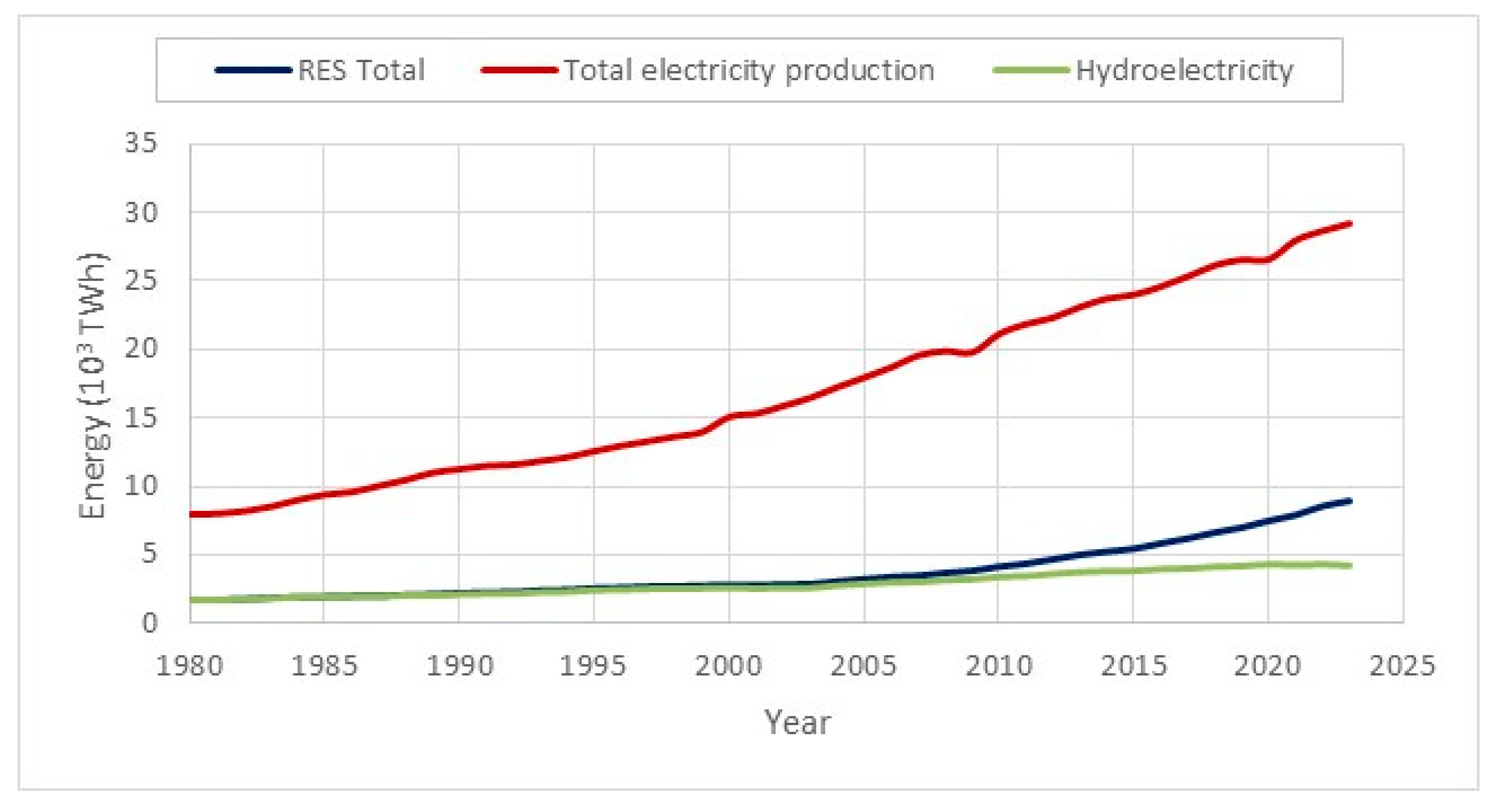
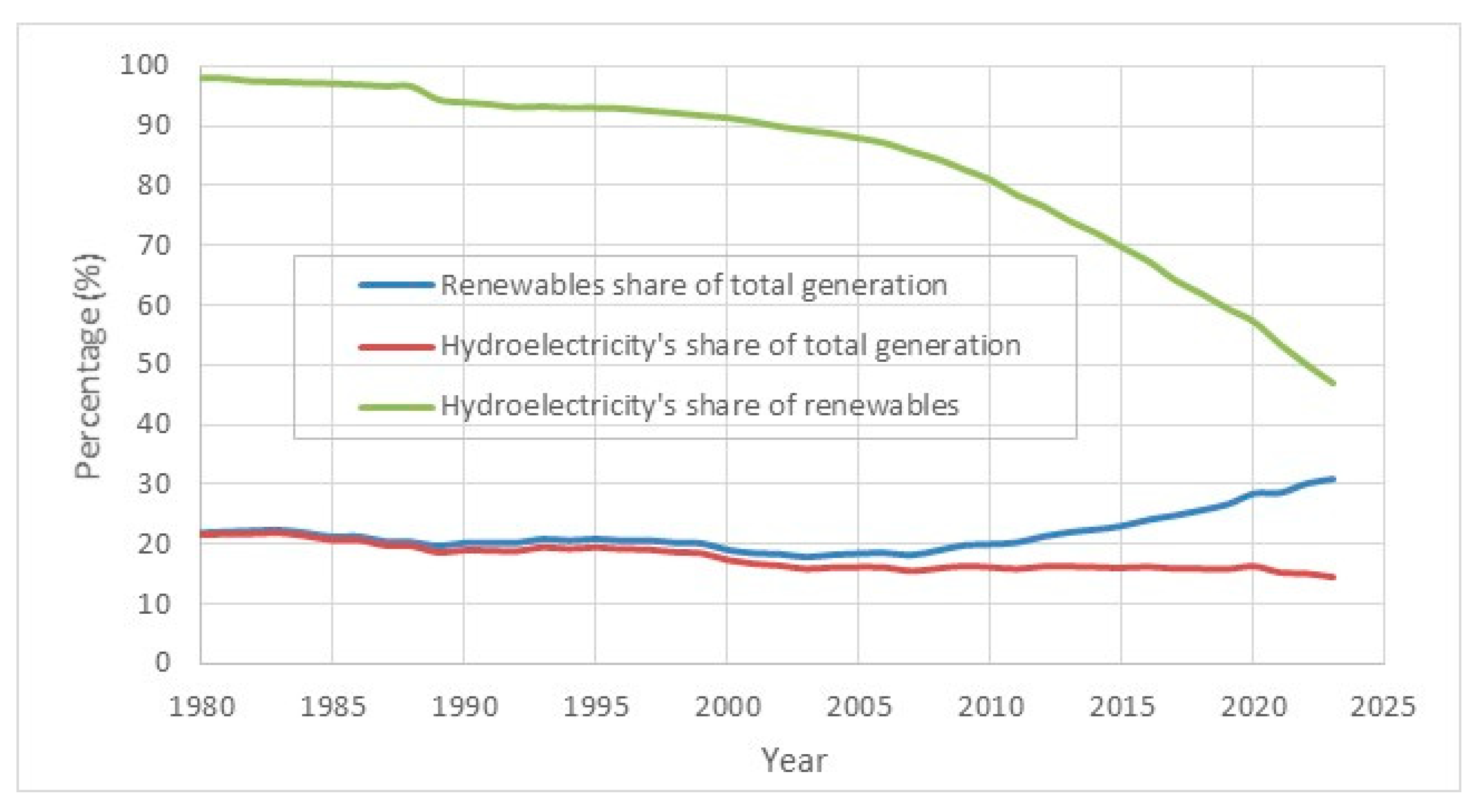

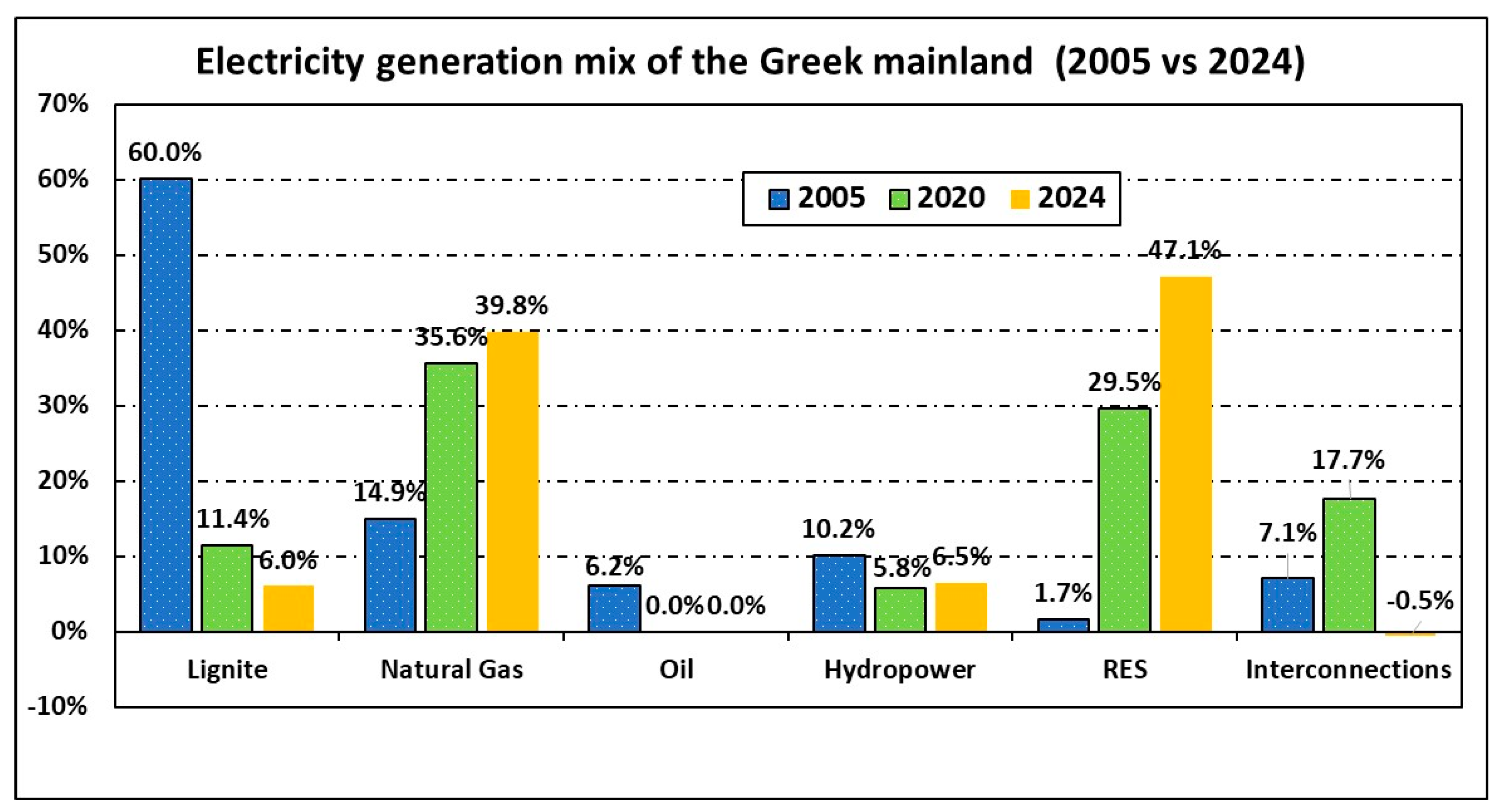



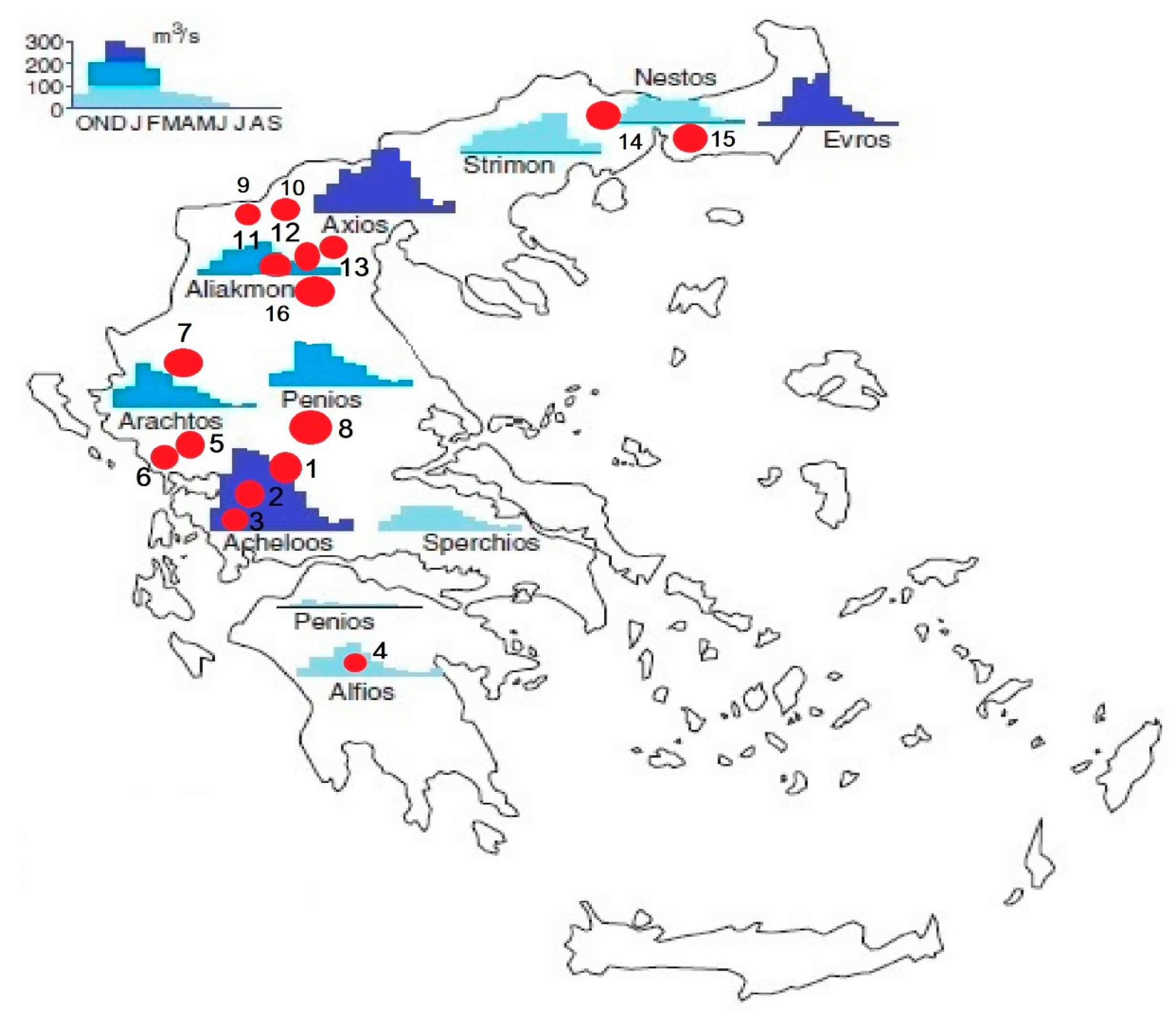
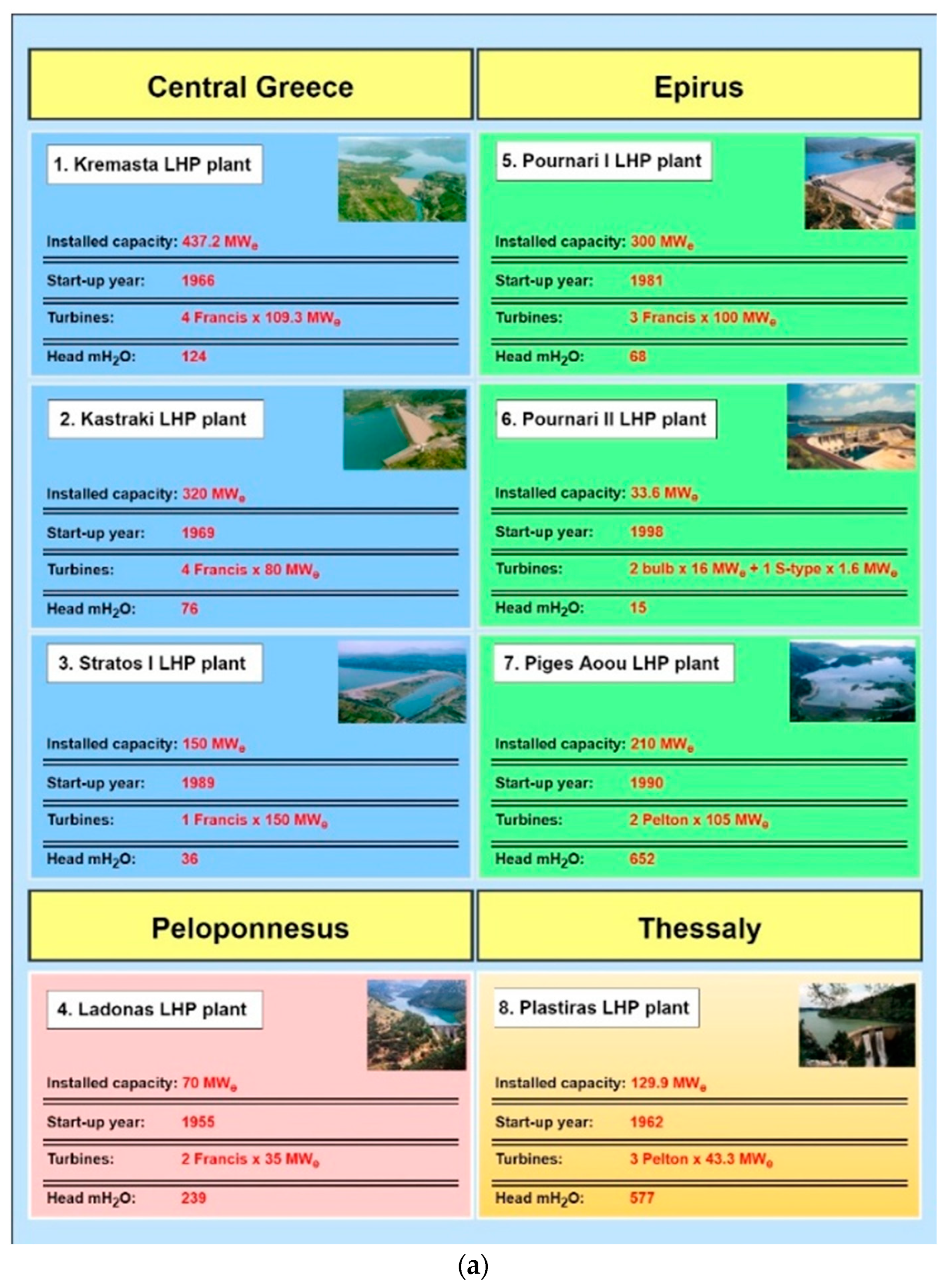
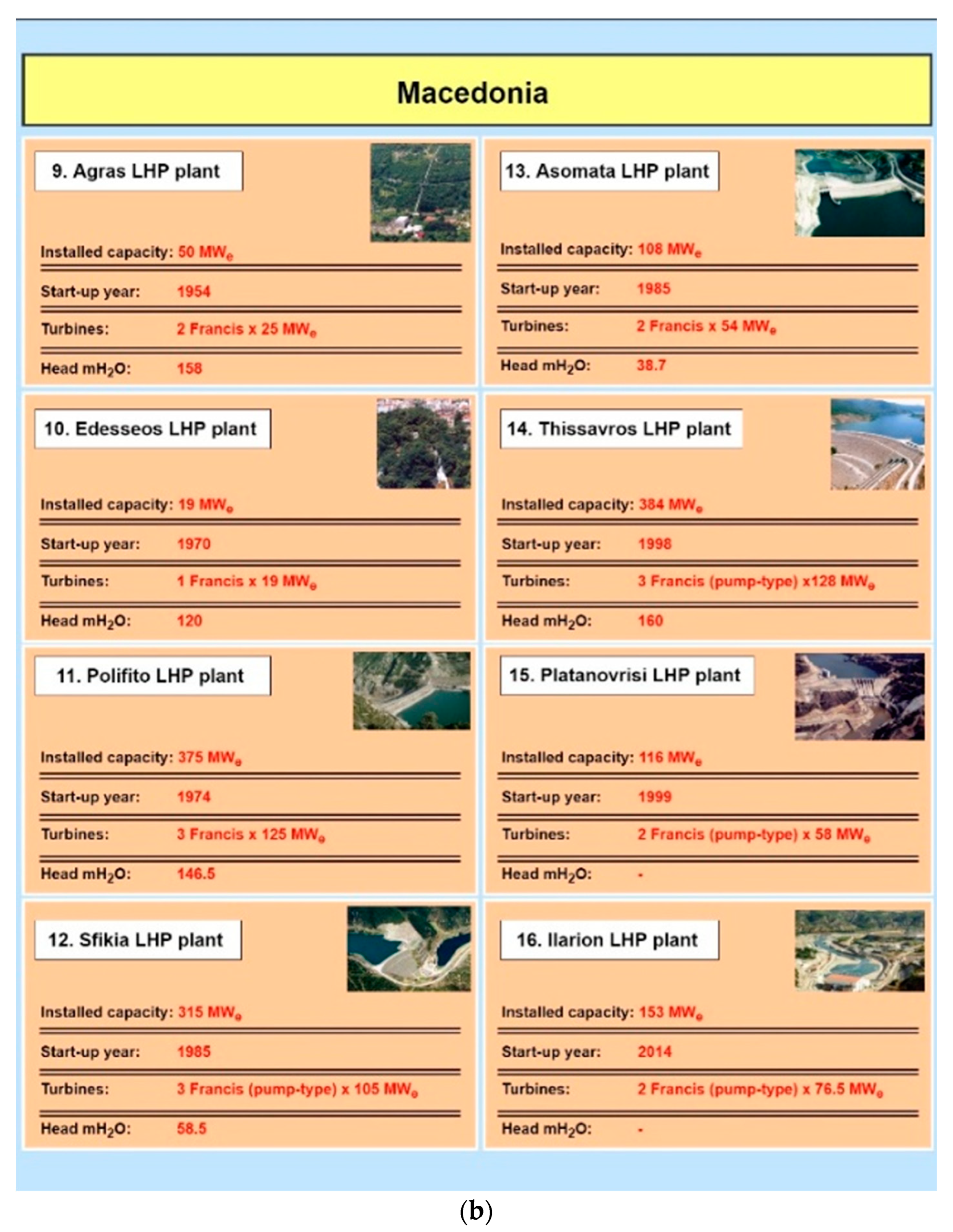
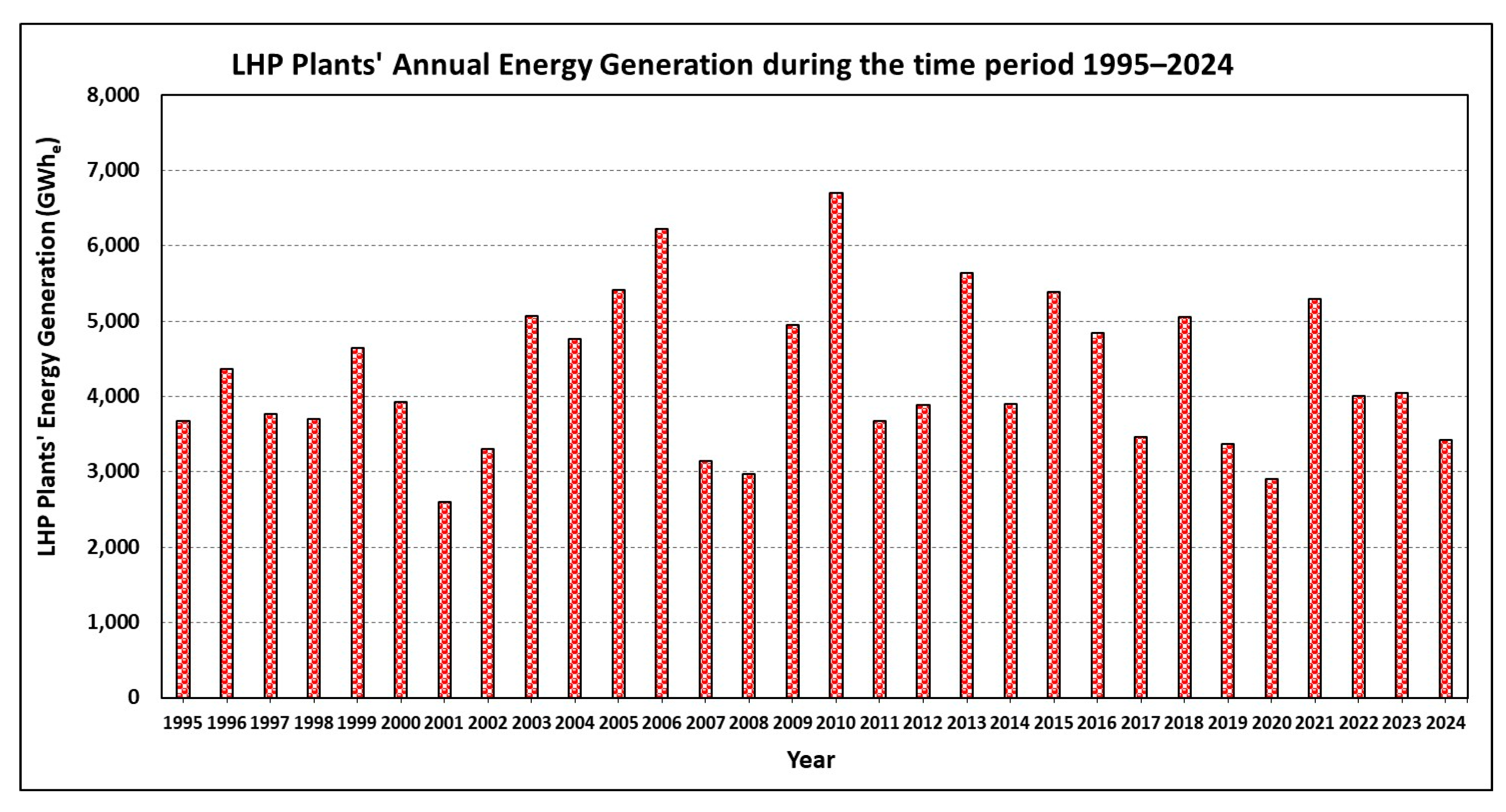

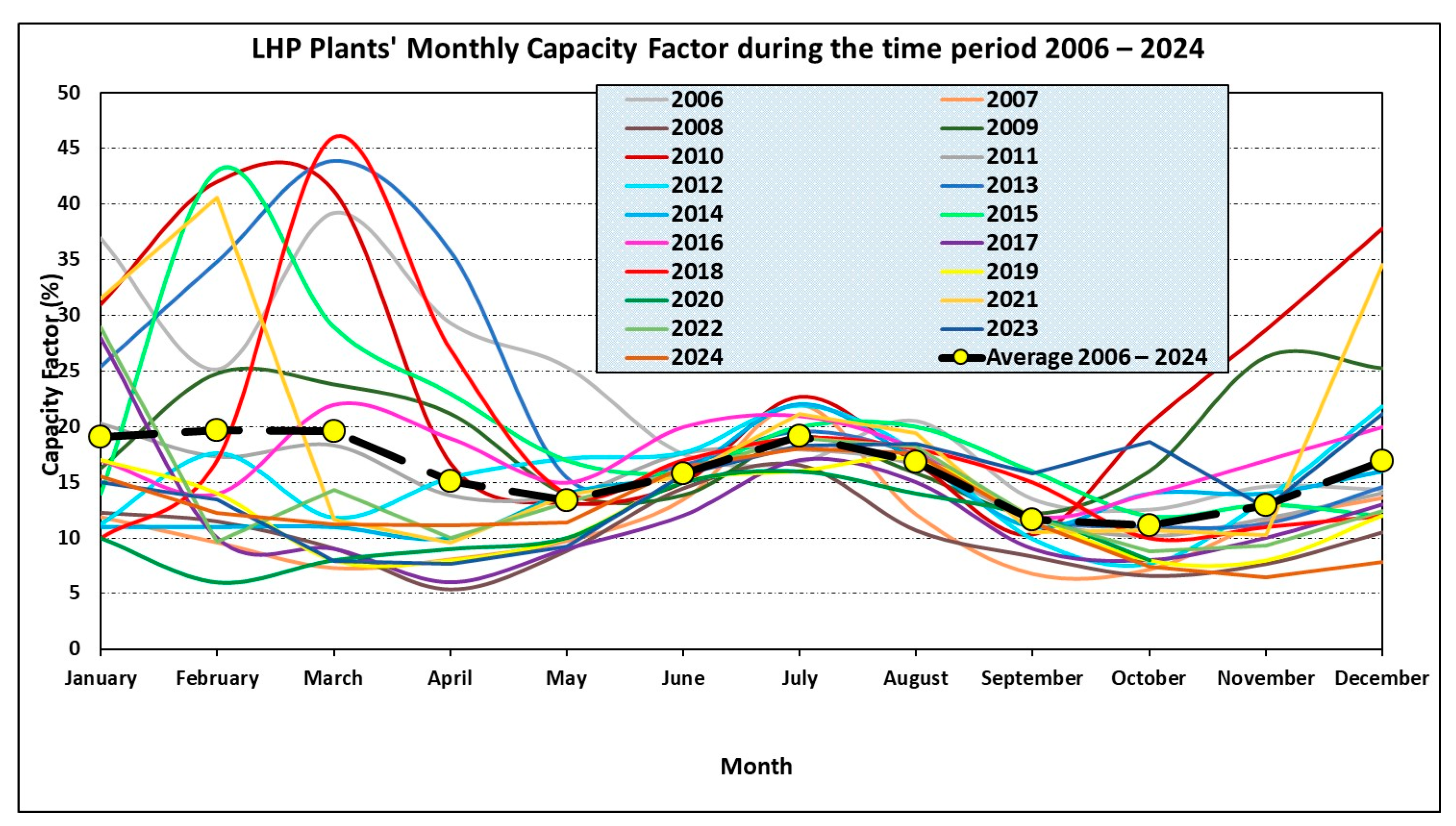
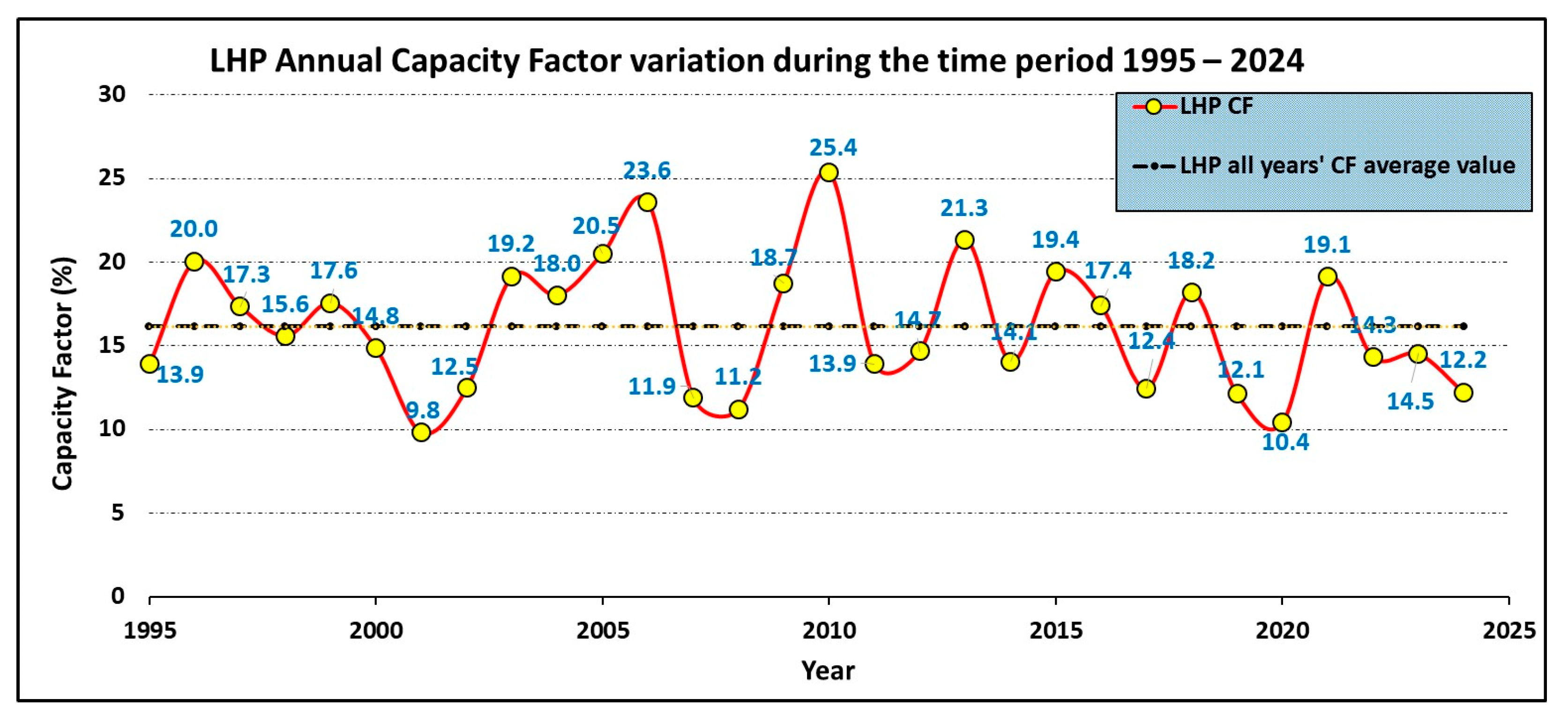

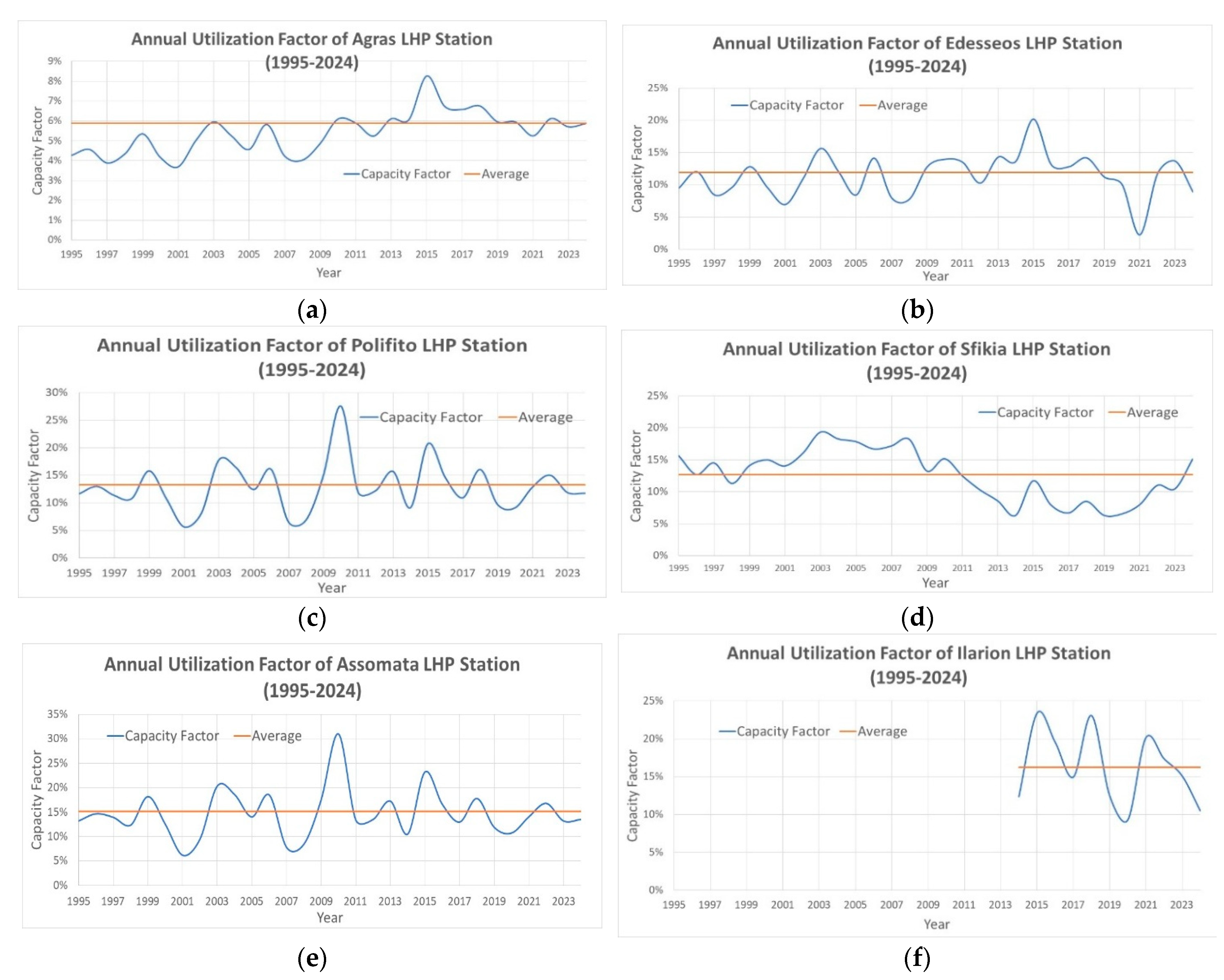
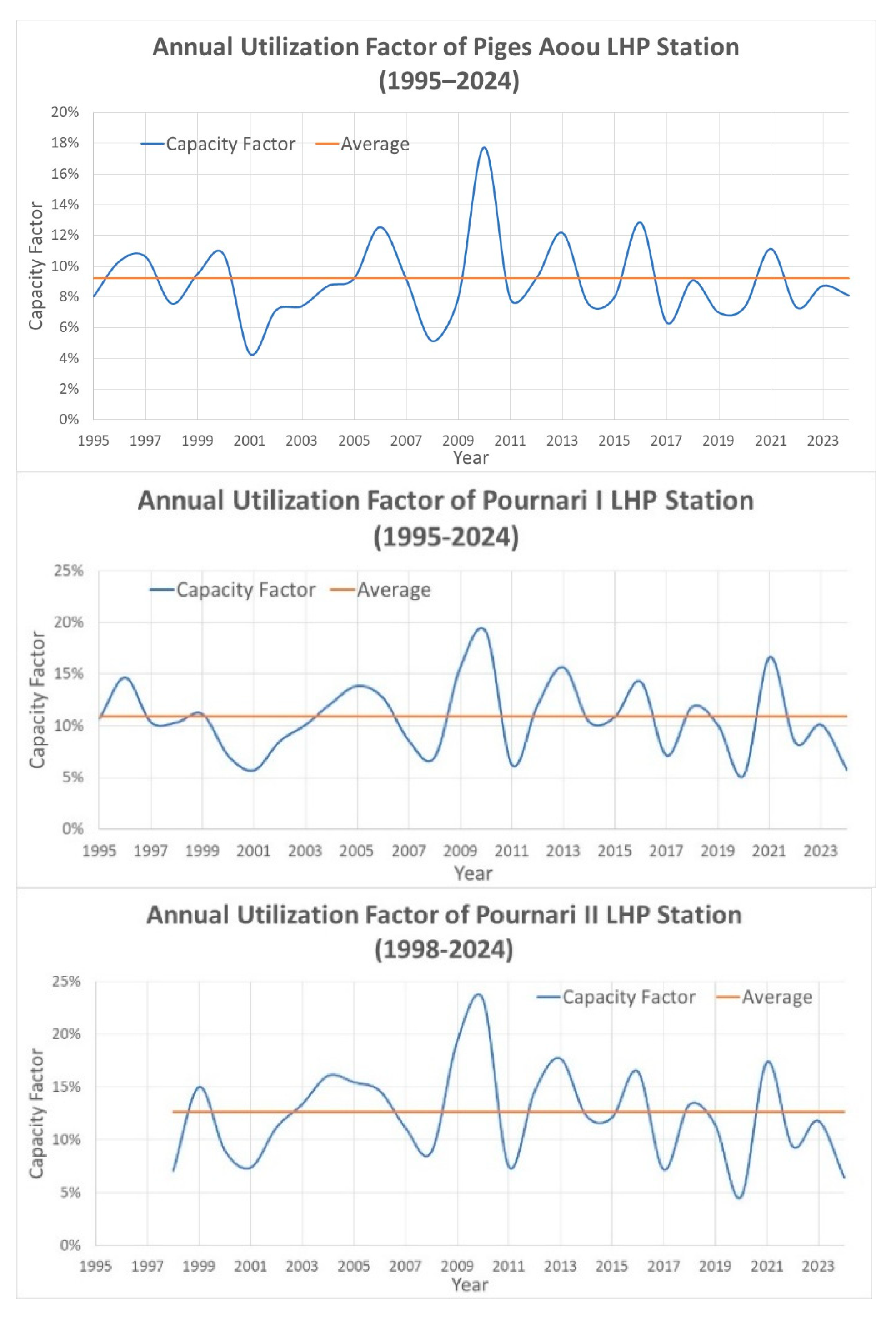





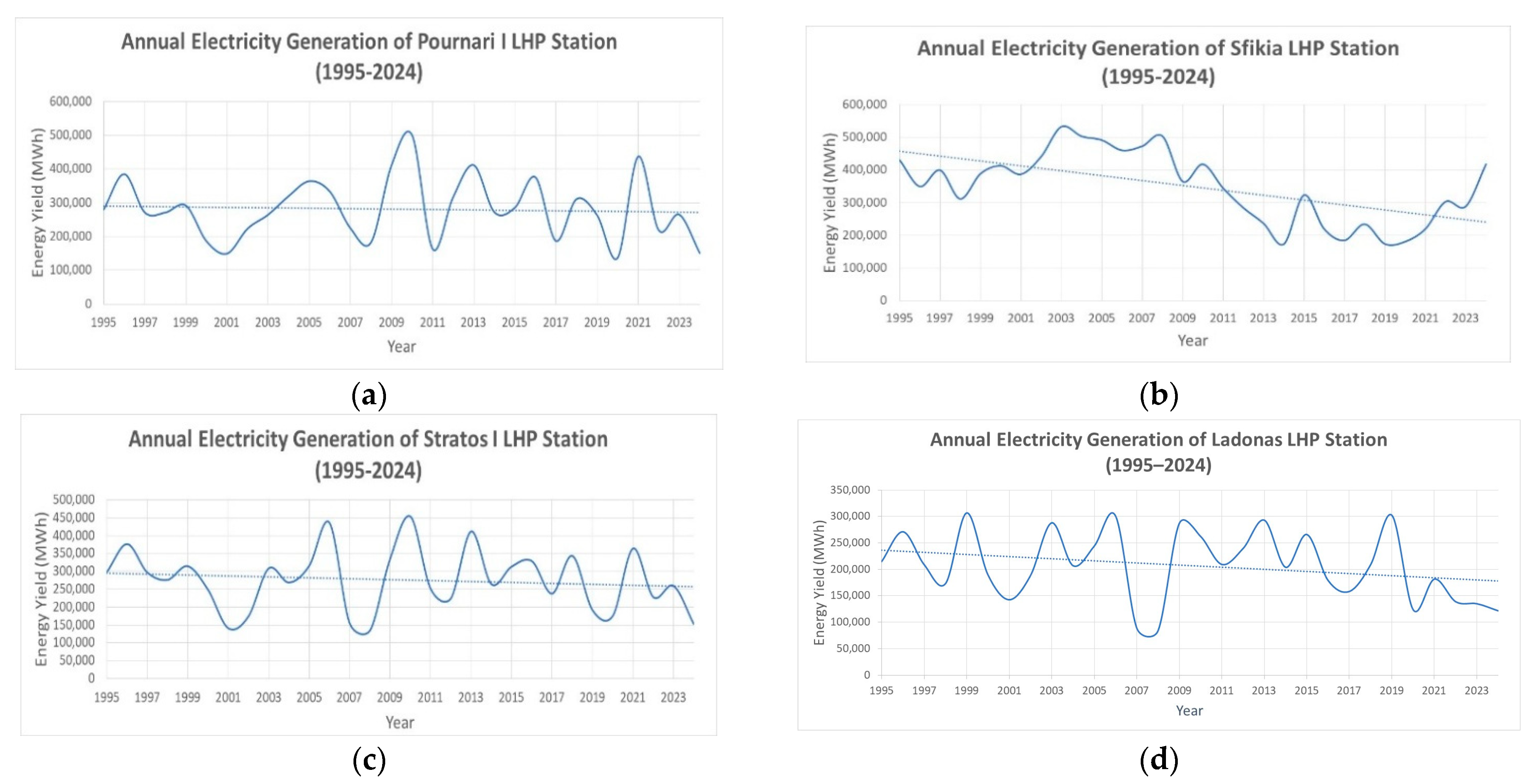
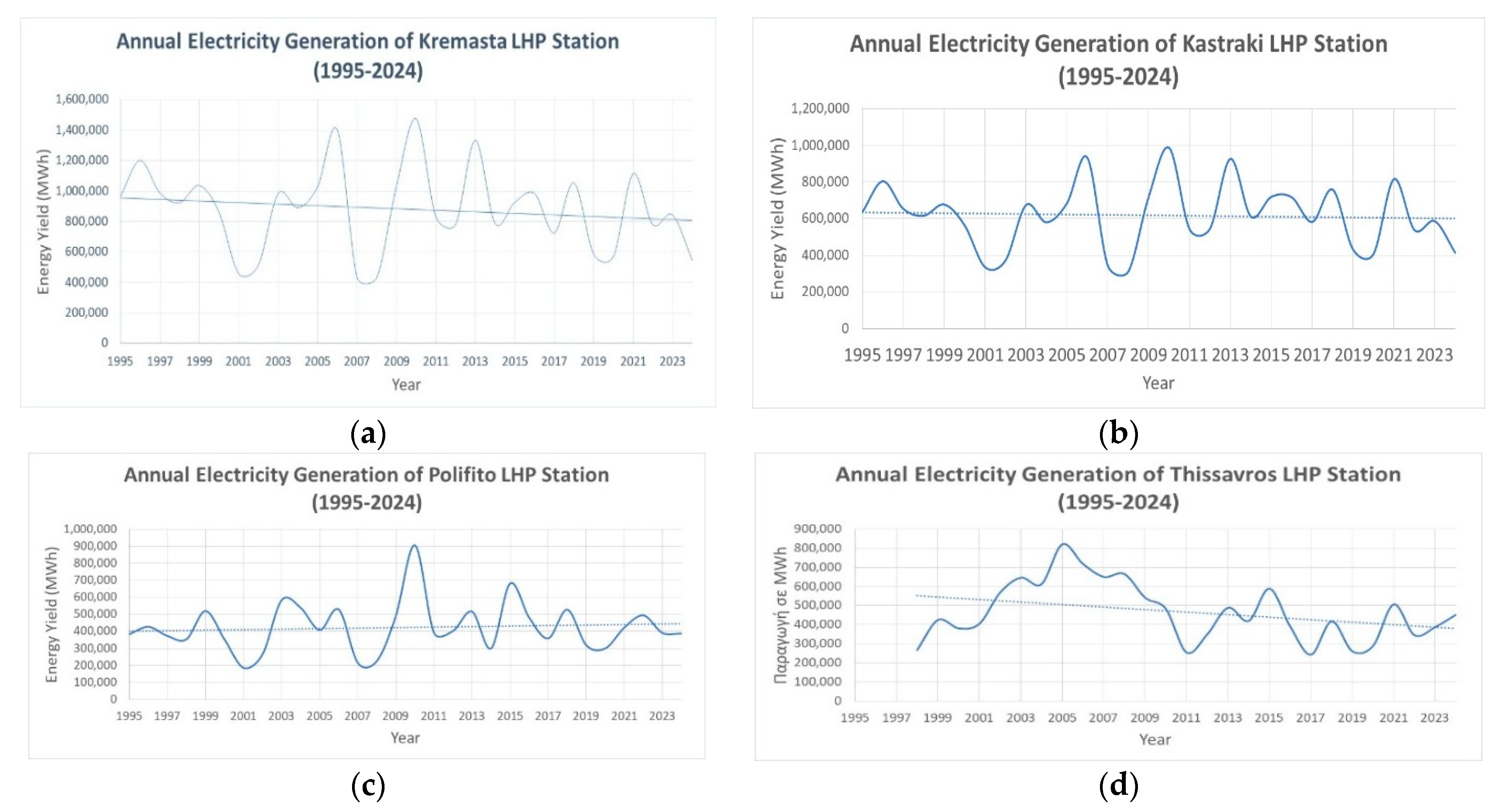

| River | Geographical District | Annual Average Water Flow Rate (m3 s−1) |
|---|---|---|
| Evros | East Macedonia–Thrace | ~110 |
| Nestos | East Macedonia–Thrace | ~90 |
| Strimon | Macedonia | ~110 |
| Axios | Macedonia | ~160 |
| Aliakmon | Macedonia | ~80 |
| Penios | Thessaly | ~80 |
| Arachthos | Epirus | ~70 |
| Acheloos | Central Greece | ~190 |
| Sperchios | Central Greece | ~60 |
| Alfios | Peloponnesus | ~70 |
| Penios (Iliakos) | Peloponnesus | ~15 |
| Electricity Generation Technology | Carbon Intensity (g CO2/kWhe) |
|---|---|
| Coal–lignite | 900–1200 |
| Natural gas | 400–500 |
| Hydropower | 15–40 1 |
Disclaimer/Publisher’s Note: The statements, opinions and data contained in all publications are solely those of the individual author(s) and contributor(s) and not of MDPI and/or the editor(s). MDPI and/or the editor(s) disclaim responsibility for any injury to people or property resulting from any ideas, methods, instructions or products referred to in the content. |
© 2025 by the author. Licensee MDPI, Basel, Switzerland. This article is an open access article distributed under the terms and conditions of the Creative Commons Attribution (CC BY) license (https://creativecommons.org/licenses/by/4.0/).
Share and Cite
Kaldellis, J.K. Long-Term Analysis of Hydropower’s Pivotal Role in Sustainable Future of Greece. Energies 2025, 18, 2214. https://doi.org/10.3390/en18092214
Kaldellis JK. Long-Term Analysis of Hydropower’s Pivotal Role in Sustainable Future of Greece. Energies. 2025; 18(9):2214. https://doi.org/10.3390/en18092214
Chicago/Turabian StyleKaldellis, John K. 2025. "Long-Term Analysis of Hydropower’s Pivotal Role in Sustainable Future of Greece" Energies 18, no. 9: 2214. https://doi.org/10.3390/en18092214
APA StyleKaldellis, J. K. (2025). Long-Term Analysis of Hydropower’s Pivotal Role in Sustainable Future of Greece. Energies, 18(9), 2214. https://doi.org/10.3390/en18092214





